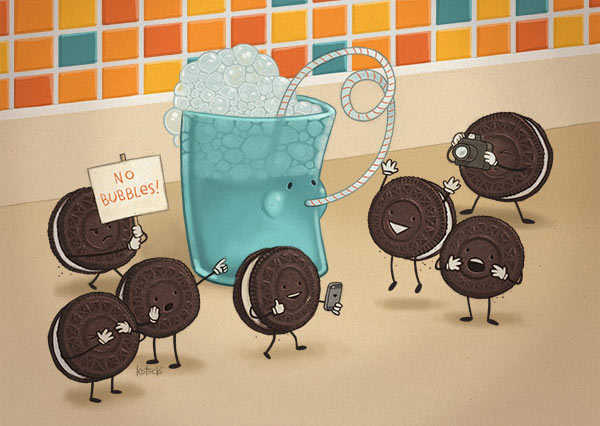
Kim and I had a big test early on in our parenting adventure.
At dinner one evening when she was about two, Lucy got to drink out of a “big girl cup” with a straw. And for the first time ever, she discovered how to blow bubbles in her milk. In our household, this is on par with first words, first steps, and learning how to dunk cookies in milk.
It’s kind of a big deal.
The coolest part is that she figured it out on her own; we didn’t have to teach her. It was awesome witnessing the moment of discovery, when surprise transformed into delight. However, when her cup had become entirely consumed by bubbles, she actually grew concerned and seemed disappointed when she asked, “Where did milk go?”
“Don’t worry, it’ll come back,” I assured her.
And as the bubbles dispersed, it did! (One of the perks of parenting is presenting the illusion of being all-knowing.)
Naturally, blowing bubbles in her milk became much more interesting to Lucy than actually eating dinner. And Adultitis strongly encouraged both Kim and me to tell her to cut it out. The inner debate about how to proceed was more crucial than one might expect. For you see, we give out little cards to every person who attends one of our speaking programs, and it features this comic strip:
We’ve handed out thousands and thousands and thousands of these cards. Would we now become the parents who admonish our child for blowing bubbles in her milk? Kim and I exchanged a look that indicated we didn’t want to be.
I stopped the inner conversation in my head and quickly analyzed the situation: What’s the big deal? What are my main concerns? For one, I wanted to make sure she actually ate her dinner in a reasonable amount of time. And secondly, I was not especially keen on cleaning up any milk-bubble overflows.
So we made it clear that she needed to keep the straw (and the bubbles) in the glass. And after a few more minutes of bubble-blowing fun, we pulled the glass away and told her she could resume after she ate a few more bites of her dinner. I was amazed at the responsiveness we got! Inadvertently, we had turned blowing bubbles in milk into an incentive more powerful than M&M’s (which up to that point, had been the currency of choice in our household)!
It’s easy to jump into automatic mode in our roles as parents, teachers or leaders and respond to situations in the same way we’ve seen other parents, teachers, and leaders do it, without ever stopping for just a second to question if there might be another way. Stopping that knee jerk-reaction is the hard part, but once we do, the other (better) way is not that hard to find.
That’s why thinking about these rules that don’t exist is such an important pastime. The more we do it, the more of them we recognize. And the easier it is to stop and search for a better way.
In the end, I think we passed the test by honoring one of the special joys of childhood while avoiding a mess and steering clear of turning into total pushovers. (It was nice to have some confidence going into potty training.…)
Meanwhile, although it may not be a preferred habit for dinner parties and state dinners, my little personal wish for Lucy is that she never stops blowing bubbles in her milk.


I really loved how you guys were able to take a situation that was so trivial (but frustrating) and accept your daughter’s love for being a kid, by reframing the whole thing and seeing it from a different perspective. So many of us get easily annoyed and dampen the fun of others by imposing our of set of rules on to people (especially kiddos) because we think we’re right. Good for you!!! <3
Thanks Naomi! It’s a simple concept, but easier said than done for sure! Fortunately, this was one of the times we got it right. :)